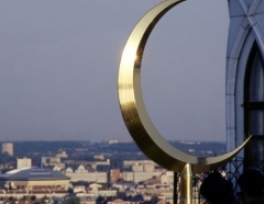
Russia’s Muslims Increasingly Radicalized by Events in the Middle East
Publication: Eurasia Daily Monitor Volume: 10 Issue: 174
By:

Russia’s Muslims continue to be radicalized not only by developments within their own community but increasingly by events in the Middle East, according to Yana Amelina, an analyst who works for a Russian research group that has close ties with the Kremlin. Her views provide a useful summary of how the Kremlin currently views the situation, even though others in the Russian Federation and the West could argue that—at least in some places—she has overstated her case.
Amelina is a specialist on the North Caucasus but increasingly writes on the Middle Volga as well. In an article in a book just published by the Russian Institute for Strategic Research, she argues that in the wake of the Arab Spring, “radical Islamism has become one of the most serious threats to public order and the government structure of the Russian Federation.” She attributes this threat to both the actions of illegal armed formations in the North Caucasus, as well as the more recent spread of the influence of their views on the Muslim communities of Tatarstan and Bashkortostan (kazan-center.ru/osnovnye-razdely/14/393/).
Amelina points to five aspects of the radicalization of Islam in the Russian Federation that she suggests are especially worrisome: First, she writes, the position of traditional Islam in Russia has been undermined by the murder of several Muslim leaders—actions that in the words of one mufti has led to “the disorientation of the umma [Muslim community].” Second, she argues that there has been “a step-by-step formation of ‘a common Islamist front’” linking the North Caucasus with the more populous Middle Volga. Third, she points to what she says is an increasingly active “Islamist lobby, which has popularized and propagandized the ideas of Islamists in the all-Russian mass media and in state structures.”
Fourth, Amelina points to “the formation of an eclectic Islamist ideology,” one combining Arab and local views. And fifth, she says that there has been “an intensified orientation to foreign and, especially, toward the Arab Islamic community, the external sign of which is the increasingly archaic quality of the radical part of the Russian umma.”
Amelina’s first three points have been challenged by many Russian and Western specialists on Islam, who argue that such conclusions are suggestive but far from definitive and that more research is required before they can be considered proven. But her last two points—about attention to the Middle East among Russia’s Muslims and the formation of a new and eclectic ideology among them—break new ground and thus merit further scrutiny because they are at the intersection point of Russian domestic and foreign policy.
According to Amelina, there is a trend toward “the Arabization of culture” across the entire North Caucasus. To support that conclusion, she points to the fact that small but significant portions of Ingush men and women identify Arabs as desirable marriage partners. Moreover, she adds that ever more North Caucasians are adopting Arab cultural markers like the hijab, something Amelina says is “acquiring (in some cases by force) ever greater popularity among the female Muslim population of the North Caucasus and Middle Volga republics.”
But she notes that it is not so much that Arab culture is displacing local culture within Russia’s umma but rather that Arab culture is taking its place alongside traditional local Islam. The resulting combination forms part of what she identifies as “an eclectic Islamist ideology,” one that serves as a bridge between the two communities. The phenomenon, she notes, explains why Russian authorities have seized both Salafi and Hizb ut-Tahrir literature from Tatar Islamists.
These observations are critically important for two reasons. On the one hand, such a melding of various ideologies would be unthinkable in most of the Muslim world and thus often does not inform either Russian or Western analyses of Islamic developments in the Russian Federation. This openness to syncretism reflects the Soviet past. Because of Moscow’s anti-religious efforts, many Muslims who grew up in the Soviet Union knew they were Muslims but did not know exactly what that meant beyond being a cultural marker. They were, as the Soviet term had it, “ethnic Muslims.” And consequently, the divisions between Sunni and Shia, which agitate the Middle East, have far less significance for many of the Muslims of the Russian Federation.
And on the other hand, the very eclecticism that Amelina points to is likely to make it far more difficult for Moscow to counter. Indeed, her article suggests that the Russian authorities will fail if they try to use their traditional “divide and rule” approach. Indeed, what Moscow may see as support for one group and opposition to another may not be seen that way by the Muslim umma in Russia today.




